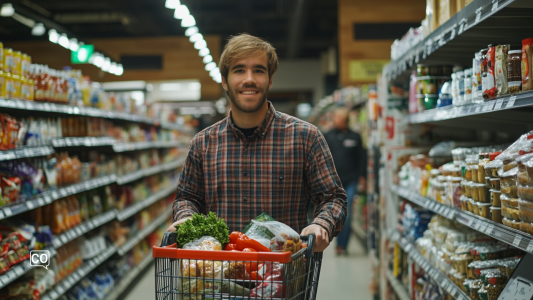Learn practical Dutch vocabulary and grammar for grocery shopping, including common food items, store locations, polite questions, and essential verb conjugations for beginners. This lesson teaches you how to make a shopping list, ask about products and prices, and use polite phrases useful for real-life situations.
Listening & reading materials
Practice vocabulary in context with real materials.
Vocabulary (16) Share Copied!
Exercises Share Copied!
These exercises can be done together during conversation lessons or as homework.
Exercise 1: Reorder sentences
Instruction: Make correct sentences and translate.
Exercise 2: Match a word
Instruction: Match the translations
Exercise 3: Cluster the words
Instruction: Divide the words into two groups: foods you eat and places where you shop.
Voedingsmiddelen
Winkels en plekken
Exercise 4: Translate and use in a sentence
Instruction: Pick a word, translated and use the word in a sentence or dialogue.
1
Het winkelkarretje
The shopping trolley
2
De vis
The fish
3
Het vlees
The meat
4
Nodig hebben
To need
5
De yoghurt
The yoghurt
Oefening 5: Conversation exercise
Instructie:
- Describe the items on the shopping list. (Describe the items on the shopping list.)
- Ask the shop assistant for the location of the products. (Ask the shop assistant for the location of the products.)
- Pay for your products at the checkout. (Pay for your products at the checkout.)
Teaching guidelines +/- 10 minutes
Example phrases:
|
Waar is / zijn ...? Where is / are ...? |
|
Kunt u mij even helpen, alstublieft? Could you help me for a moment, please? |
|
Mag ik een bonnetje? Could I have a receipt? |
|
Is dit product in de aanbieding? Is this product on sale? |
|
Kan ik contant betalen / met pinpas? Can I pay in cash / by card? |
|
Heb je een tas? Do you have a bag? |
|
Is deze prijs correct? Is this price correct? |
|
Kan ik u helpen? Can I help you? |
| ... |
Exercise 6: Dialogue Cards
Instruction: Select a situation and practice the conversation with your teacher or fellow students.
Exercise 7: Multiple Choice
Instruction: Choose the correct solution
1. Ik ___ elke week verse groenten en fruit in de supermarkt.
(I ___ buy fresh vegetables and fruit at the supermarket every week.)2. Wij ___ vaak samen op de markt voor het avondeten.
(We ___ often shop together at the market for dinner.)3. Hij ___ niet beslissen welke yoghurt hij wil kopen.
(He ___ cannot decide which yogurt he wants to buy.)4. ___ ik meer koekjes aan mijn boodschappenlijst toevoegen?
(___ I add more cookies to my shopping list?)Exercise 8: Grocery Shopping for the Family
Instruction:
Verb Tables
Gaan - To go
Onvoltooid tegenwoordige tijd
- ik ga
- jij gaat
- hij/zij/het gaat
- wij gaan
- jullie gaan
- zij gaan
Maken - To make
Onvoltooid tegenwoordige tijd
- ik maak
- jij maakt
- hij/zij/het maakt
- wij maken
- jullie maken
- zij maken
Nemen - To take
Onvoltooid tegenwoordige tijd
- ik neem
- jij neemt
- hij/zij/het neemt
- wij nemen
- jullie nemen
- zij nemen
Zoeken - To look for
Onvoltooid tegenwoordige tijd
- ik zoek
- jij zoekt
- hij/zij/het zoekt
- wij zoeken
- jullie zoeken
- zij zoeken
Vragen - To ask
Onvoltooid tegenwoordige tijd
- ik vraag
- jij vraagt
- hij/zij/het vraagt
- wij vragen
- jullie vragen
- zij vragen
Betalen - To pay
Onvoltooid tegenwoordige tijd
- ik betaal
- jij betaalt
- hij/zij/het betaalt
- wij betalen
- jullie betalen
- zij betalen
Lopen - To walk
Onvoltooid tegenwoordige tijd
- ik loop
- jij loopt
- hij/zij/het loopt
- wij lopen
- jullie lopen
- zij lopen
Vinden - To like
Onvoltooid tegenwoordige tijd
- ik vind
- jij vindt
- hij/zij/het vindt
- wij vinden
- jullie vinden
- zij vinden
Grammar Share Copied!
It's not the most exciting thing, we admit, but it’s absolutely essential (and we promise it'll pay off)!
Verb conjugation tables for this lesson Share Copied!
Kopen buy Share Copied!
Onvoltooid tegenwoordige tijd (OTT)
| Dutch | English |
|---|---|
| (ik) koop | I buy |
| (jij) koopt | you buy |
| (hij/zij/het) koopt | he/she/it buys |
| (wij) kopen | we buy |
| (jullie) kopen | you buy |
| (zij) kopen | they buy |
Winkelen shopping Share Copied!
Onvoltooid tegenwoordige tijd (OTT)
| Dutch | English |
|---|---|
| (ik) winkel | I shop |
| (jij) winkelt | you shop |
| (hij/zij/het) winkelt | he/she/it shops |
| (wij) winkelen | we are shopping |
| (jullie) winkelen | you are shopping |
| (zij) winkelen | they are shopping |
Don't see progress when learning on your own? Study this material with a certified teacher!
Do you want to practice Dutch today? That is possible! Just contact one of our teachers today.
Welcome to Grocery Shopping in Dutch
This lesson is designed for beginners (A1 level) learning Dutch and focuses on practical language skills needed for grocery shopping. You'll learn common vocabulary about food items and places related to shopping, such as de groente (vegetables), de vis (fish), de yoghurt (yogurt), and important locations like de supermarkt (supermarket), de markt (market), and de kassa (cash register).
Key Language Skills
The course covers making a shopping list, asking for products, inquiring about prices and quantities, and completing purchases. You will practice dialogues such as asking where to find fresh vegetables or discussing how much something costs. For example, questions like "Heeft u verse groenten?" (Do you have fresh vegetables?) or "Hoeveel kost een brood?" (How much does a loaf of bread cost?) will become familiar.
Grammar Focus
You will also work on essential verb conjugations in the present tense related to shopping actions, such as koop (I buy), winkelen (to shop), kan (can), and moet (must). Exercises include filling in gaps with the correct verb form, enhancing your understanding of how to communicate effectively in practical situations.
Mini Story for Context
The lesson features a short, relatable story about a family grocery shopping trip. It introduces verbs in context like gaan (to go), maken (to make), zoeken (to look for), and betalen (to pay), providing a natural way to see vocabulary and grammar at work.
Differences in Instruction and Language Use
In Dutch shopping interactions, polite forms are key. For example, using "Heeft u..." instead of just "Heb je..." shows respect and is common in stores. Unlike English, where you may simply say "Do you have fresh vegetables?", in Dutch you often add "alstublieft" (please) to sound polite: "Heeft u verse groenten, alstublieft?" There are also specific words for places that differ notably, such as "de markt" meaning "the market," which is often an open-air place rather than a supermarket.
Essential Phrases
- Waar vind ik...? — Where can I find...?
- Hoeveel kost...? — How much does... cost?
- Mag ik...? — May I have...?
- Ik heb nodig... — I need...
By mastering these phrases, you can navigate most grocery shopping situations in Dutch with confidence and politeness.


























